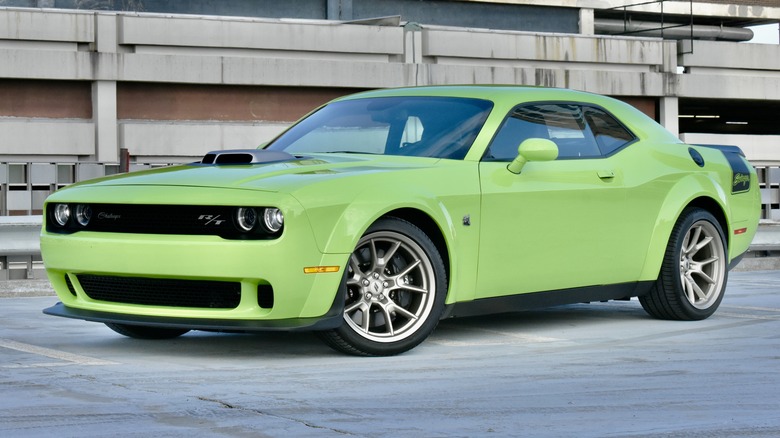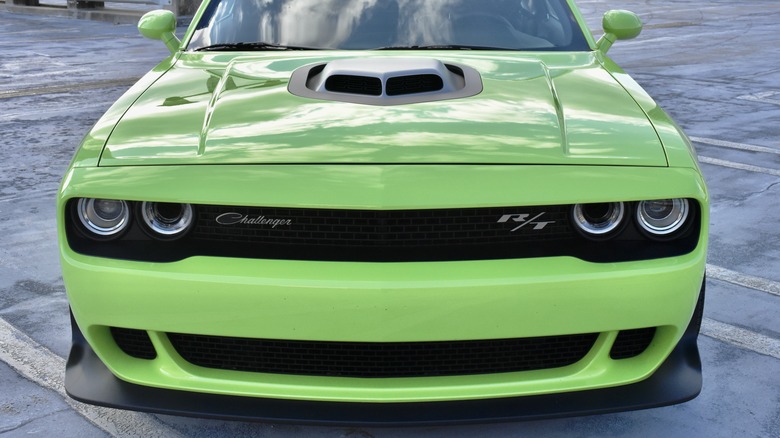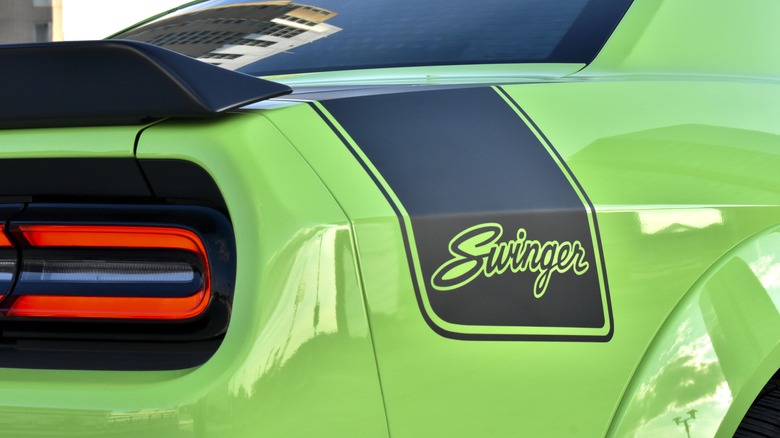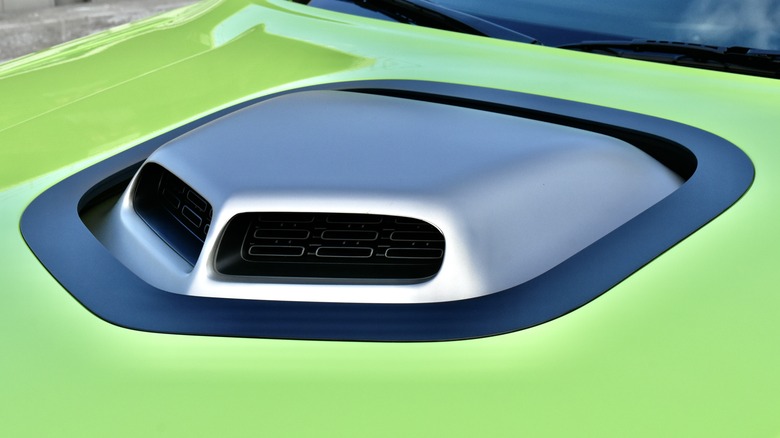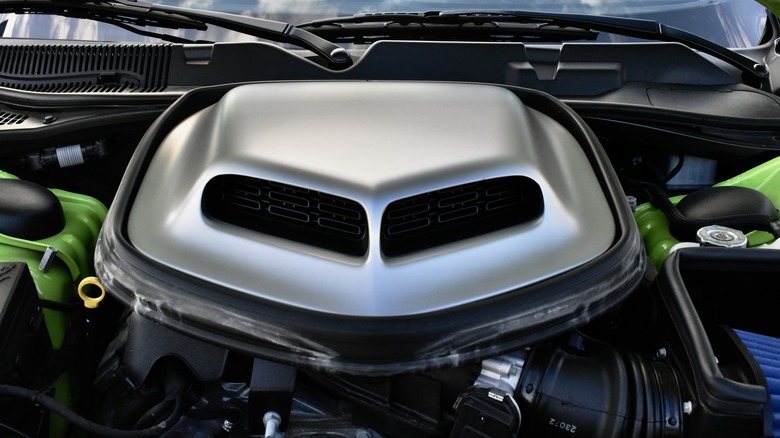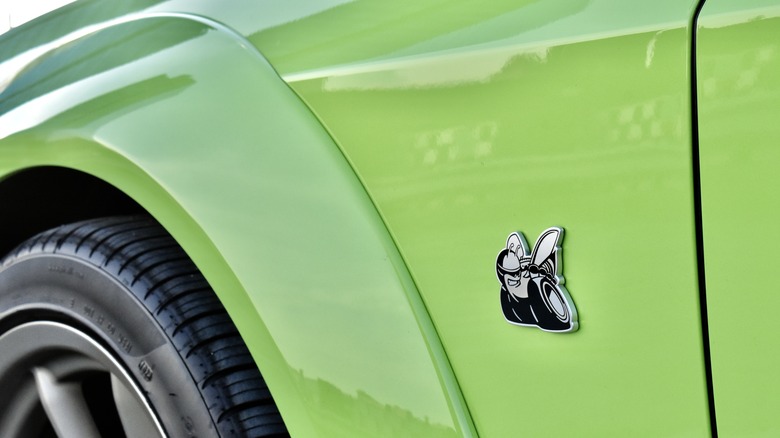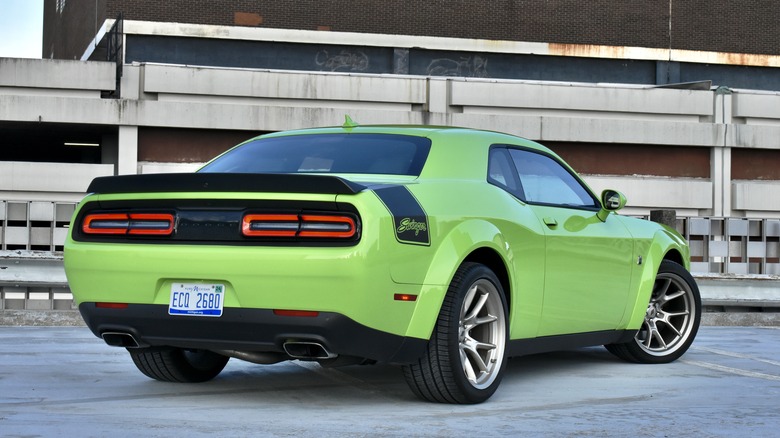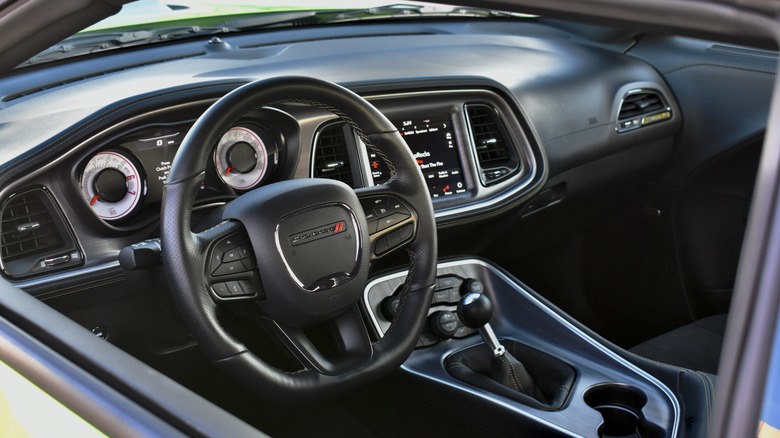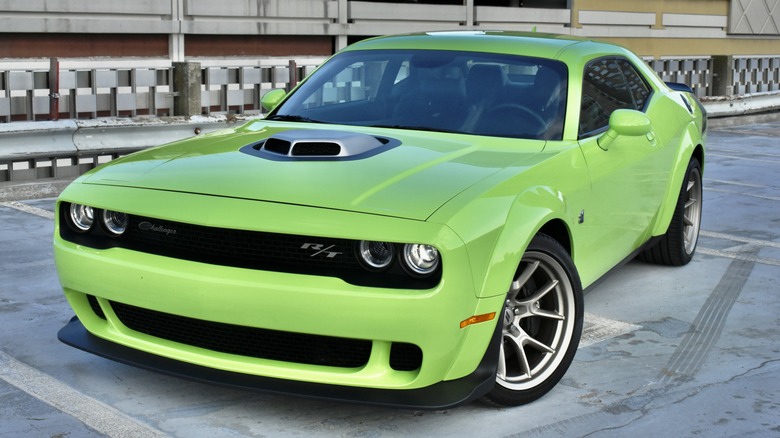2023 Dodge Challenger Swinger Review: A Muscle Car's Last Call
- Distinctive styling
- Old school V8 thrills
- Fun personality
- Outdated interior
- High as-tested price
It's not unusual for an automaker to draw on nostalgia for a bygone era, but Dodge has been doing it for so long that its Challenger coupe has itself become a relic. And now it's finally heading to a museum.
Limited to 1,000 units, the 2023 Dodge Challenger Swinger is one of seven "Last Call" special editions marking the final model year for both the current Challenger and its Charger sedan sibling. The last examples will leave the factory later this year. Both are expected to be replaced with an EV previewed by the Charger Daytona SRT concept, and due to arrive in 2024.
The heavy-handed symbolism of a pair of V8-powered muscle cars being replaced by an EV is enough to make bald eagles cry, but it's not the most interesting part of the story. Both the Charger and Challenger have been in production without full redesigns since the 2000s, making them remarkably long-lived by auto industry standards. The Challenger also looks largely the same, wearing styling reminiscent of the first-generation Challenger, the production of which it's now exceeded many times over. Both the 20th and 21st century Challengers were designed to take on the Ford Mustang and Chevrolet Camaro, but while those cars have changed and evolved, the Challenger has stayed the same.
The Challenger is a love letter to 1970, when the original muscle car era peaked, but one that was originally posted on Myspace. Unlike most early social media posts, though, it's aged quite well.
Out of time
Like World War II veteran Captain America surviving into the 21st century by being frozen in ice, this archetypal American muscle car has lived beyond its years through artificial means.
The original Dodge Challenger is one of the most iconic muscle cars, but it had a relatively short production run lasting only from 1970 to 1974. Dodge was fairly late in coming up with a Ford Mustang rival, so the Challenger didn't get much time before fuel economy rules and high insurance premiums brought an end to the golden age of muscle cars. A second-generation Challenger based on the Mitsubishi Galant Lambda appeared in the late 1970s, but it seems Dodge and its fans would rather forget that one.
Dodge didn't forget the original Challenger, though. In 2006, with retro automotive design and retro American jingoism all the rage, it showed a concept car recapitulating the look of the 1970 classic. The concept evolved into a production model that launched in 2008 and—with a notable update in 2014—that is the car you see here. To put that in perspective, the Challenger's run spans two and a half generations of Mustang.
Millennial styling
The Challenger's elongated shelf life also means it's as much a retro tribute to the early 2000s as it is to the early 1970s. It has the same general shape as the original, including a snorkel-like grille and rear fenders that pinch the quarter windows, giving the car a hunkered-down look when viewed in profile.
However, the original Challenger was also designed before modern crash-safety standards. So the modern version has much thicker roof pillars and body sides to increase roof strength and make room for side-impact crash structures, respectively. To adapt the 20th century styling elements to 21st century safety standards, designers squared off more of the surfaces. The result is a car that looks a bit like it was milled from a solid block of metal.
When this Challenger was new, the Ford Mustang and Chevrolet Camaro took similar styling approaches. But as the retro trend subsided, Ford and Chevy gradually diverged with updated designs. In its final model year, the Challenger thus looks even more distinctive than ever.
Swinging and shaking
As one of the seven Last Call special editions, the Challenger Swinger doubles down on nostalgia—even for other cars.
The Swinger name was never used on the Challenger in period. The Dodge Dart Swinger was one of the sportier versions of what was then Dodge's entry-level compact car. Having apparently run out of other names, Dodge decided to recycle it. It's not a bad name, admittedly, provided you don't look too closely at alternative definitions of "swinger."
Our test car was an homage to muscle-car-era styling, when the colors were as loud as the engines. Its Sublime green paint (a darker F8 green is also available) is one of the classic colors from the original Challenger, and it's paired with black graphics and spoilers just like it would've been back in the day. The Swinger also gets another period piece: a Shaker hood scoop, so named because it shakes when you rev the engine.
The bright green color turned some people off, and you likely won't be viewed as the most sophisticated person if you rev the engine to watch the hood scoop move, but this spec encapsulates what the Challenger is about. This isn't a subtle, mature car. It's managed to stick around this long by playing up the fun and socially irresponsible aspects of classic muscle cars. For this sendoff special, rental car silver simply wouldn't do.
Hemi power
Another retro aspect of the Challenger is its stunning array of build configurations. This was once common practice among the Detroit automakers, but pretty much only applies to pickup trucks these days.
The Challenger Swinger has Dodge's 6.4-liter Hemi V8 under its hood. This is the penultimate engine in terms of power, sitting above the base 3.6-liter V6 and the 5.7-liter Hemi V8, but below the 6.2-liter supercharged Hellcat V8 engine, a 1,025-horsepower version of which powers the very last Challenger, the Demon 170. The Swinger's 485 hp (and 475 pound-feet of torque) doesn't seem like much in comparison, but that's more a testament to the unlikely existence of a 1,025-hp production car than to this Challenger's accelerative abilities.
In fact, it shows why some car enthusiasts never got over the end of the original muscle car era. In this Challenger, every stoplight and highway on-ramp is an event. It provides the feeling of acceleration you want in a performance car without kneading your internal organs or carrying you into highly illegal territory before you realize what's happening. And its accompanied with an engine note that's movie-soundtrack iconic.
Chassis upgrades produce mixed results
Adding to the experience is a six-speed manual transmission. It wasn't the best stick shift, but running the V8 up through the gears was so much fun it didn't matter. The shifter required a deliberate action that seemed appropriate for such a beefy car, and while the clutch was a bit hard to modulate, it required surprisingly little effort to push. With manual transmissions dwindling, we're well past having the luxury of being picky. And there's also an eight-speed automatic available.
Swinger models also get the Widebody treatment, which adds fender flares that visually balance the mostly flat front and side surfaces, with wider 305/35ZR20 Pirelli all-season tires beneath wrapped around 20x11-inch wheels. The extra rubber should mean more grip, but it didn't really feel that way from behind the wheel.
Similarly, the Swinger has what's billed on the window sticker as "Widebody Competition Suspension" that sounds more impressive than it is. When it comes to handling, the Ford Mustang and Chevrolet Camaro left the Challenger in their wakes a long time ago. At least the brakes—including six-piston Brembo front calipers—lived up to the hype with drama-free deceleration.
Old school driving experience, remastered
The Challenger, then, isn't the car for those only concerned about lap times. While its rivals have chased more sports-car-like handling, the Challenger remains a throwback to the original muscle cars, which were never very good about going around corners in the first place.
While it's always tempting to unleash that wonderful-sounding V8, the Challenger Swinger is best enjoyed at moderate speeds. It still has plenty of low end torque to squirt you down straightaways, and the tires and suspension are in their sweet spot. Any faster and the car quickly starts to lose its composure. Its width, combined with slow steering, also make for a claustrophobic feeling on narrow backroads.
The Challenger, then, remains an old school muscle car to the end. It devours straight sections of road, but only nibbles on corners. And that's okay. With its sonorous engine and manual transmission, this car is plenty of fun to drive regardless of how fast you're going. So unlike many other modern performance cars, you don't have to reach illegal speeds to feel something. It's not technically competent, but it sure is entertaining.
Interior shows its age
If the Challenger has a true weak point, it's the interior. Because, while the exterior styling and driving dynamics are delightfully old school, the interior is just plain old. The design dates back to the Challenger's last major refresh in 2014 (for the 2015 model year), which brought a new dashboard designed to accommodate modern infotainment touchscreens.
Shared with other Stellantis vehicles, the Uconnect infotainment system is a model of good user-interface design. The Swinger also gets the SRT Performance Pages app, which lets you monitor the engine's power output, time acceleration runs, and track g-forces, among other things. But it's clear from the way the 8.4-inch touchscreen bulges out of the dashboard that it wasn't originally intended to be there. The rest of the interior lacks of the character of the exterior, leaving it an aesthetic gray area.
Style aside, the Challenger is fairly spacious for a two-door car. It's so big, and the driving position is so high, that shorter drivers will feel like they're sitting on a booster seat. Taller drivers, who might find the shrink-wrapped Mustang and Camaro to be a less-comfortable fit, will be right at home. The seats—upholstered in Nappa leather and Alcantara—were decently comfortable as well.
A delightful anachronism
As a 2023-model-year vehicle, the Dodge Challenger is flawed. It seems big and clumsy in comparison to rivals, its interior is dated, and most of its character is based on V8 engines that deliver atrocious fuel economy (we averaged 14.5 mpg over a week of driving). Dodge's reliance on nostalgic special editions like the Swinger shows the Challenger is very much off-trend and, with an as-tested price of $66,815, the Swinger doesn't offer cheap thrills like the original muscle cars. Yet it's sad to see this car go.
From its retro design to its distinctive driving experience, the Challenger is just plain fun. It's a car you don't have to take seriously to appreciate. And thanks to its aged design, it's refreshingly simple in the modern context of tech-heavy cars. Conventional wisdom says Dodge should have redesigned the Challenger years ago, but car enthusiasts should be thankful that it didn't.
Nothing lasts forever, though. The electrification imperative has done what rival muscle cars and high gas prices could not and finally brought an end to the Millennial Challenger. Dodge's promised electric muscle car creates some exciting possibilities, but this is truly the end of an era.
